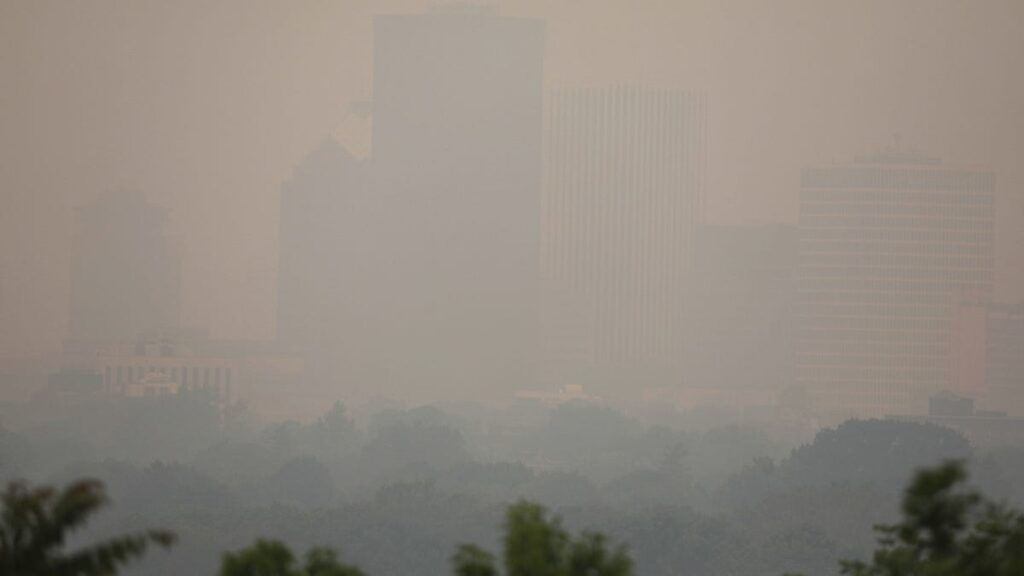Smoke from devastating wildfires raging in Canada has created a significant public health crisis, affecting air quality and prompting warnings across several U.S. states. As the flames engulf hundreds of thousands of acres, the effects are felt not just in Canada but also in the Northern Plains and Midwest regions of the United States. In this article, we explore the latest developments concerning the wildfires, the health implications of smoke inhalation, and the regions most impacted.
The Wildfire Crisis in Canada
The wildfires in Canada—particularly in Saskatchewan and Manitoba—have reached alarming levels. According to officials, these are among the worst wildfires in Canada’s recorded history, prompting widespread evacuations. The province of Manitoba alone has seen over 17,000 residents displaced, marking the largest such event in recent memory. Premier Wab Kinew has declared a provincewide state of emergency to manage the crisis.
This year’s fires follow consecutive years of destructive fire seasons across Canada, worsened by climate change. Longer and more severe fire seasons are now the norm, bringing both human tragedy and lasting environmental consequences.
Air Quality Deterioration Across the U.S.
As smoke from the wildfires drifts south, air quality in numerous U.S. states has significantly worsened. States like Wisconsin, Michigan, and Minnesota have issued air quality alerts, urging residents to take precautions.
In Minnesota, a red alert has been declared, indicating that the air is unhealthy for everyone. The Minnesota Pollution Control Agency has warned:
“Another round of heavy surface smoke will enter northwestern Minnesota… there is high confidence that all Minnesotans will experience some level of air quality impact from smoke.”
Wisconsin’s alert is expected to remain in effect until at least Saturday, with officials warning vulnerable populations—such as children and individuals with respiratory conditions—to stay indoors.
Health Risks Associated with Wildfire Smoke
The health risks from wildfire smoke are severe and can persist long after the fires are extinguished. Studies published in the journal Epidemiology show increased hospitalizations for cardiovascular and respiratory issues—such as hypertension and heart attacks—linked to smoke exposure.
According to the U.S. Environmental Protection Agency (EPA), wildfire smoke contains fine particulate matter (PM2.5), carbon monoxide, and other pollutants that can aggravate asthma, trigger respiratory infections, and increase the risk of long-term health complications.
At-risk populations are urged to:
- Limit outdoor activities
- Use air purifiers or wear N95 masks indoors
- Stay informed via local health departments or weather alerts
Monitoring Air Quality
Authorities recommend that residents in impacted areas monitor real-time air quality updates. Websites such as fire.airnow.gov offer interactive maps and forecasts to help individuals track pollution levels in their area.
Forecasting Future Conditions
Meteorologists warn that shifting weather patterns could bring more smoke into U.S. regions, particularly the Midwest. While rain in some areas may temporarily clear the air, changes in wind direction could worsen air quality in others. Ongoing forecasts remain critical to planning public health responses and personal safety measures.
Future Trends in Wildfire Management
The increasing frequency and severity of wildfires call for stronger wildfire management strategies. These include not only emergency response efforts but also proactive measures like:
- Sustainable land and forest management
- Improved firefighting infrastructure
- Climate mitigation policies
Long-term resilience will depend on cooperation among governments, scientists, and local communities to implement these strategies.
Public Awareness and Community Action
Community-level efforts are equally important. Public education on the health impacts of wildfire smoke, as well as steps to reduce exposure, can greatly enhance regional preparedness. Initiatives focused on cleaner air, climate adaptation, and local action empower citizens and reduce long-term risk.
Conclusion
The ongoing wildfires in Canada are more than a local emergency—they represent a cross-border environmental and public health crisis. With air quality alerts across multiple U.S. states and mounting health concerns, staying informed and taking preventive measures is crucial.
As we confront the growing consequences of wildfire seasons intensified by climate change, it’s vital for individuals, communities, and governments to act decisively—for health, safety, and sustainability.

